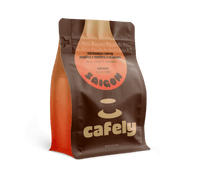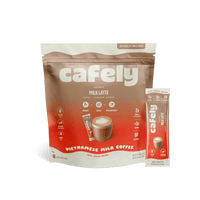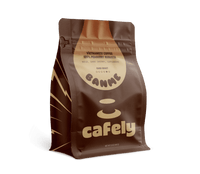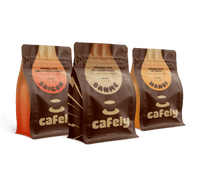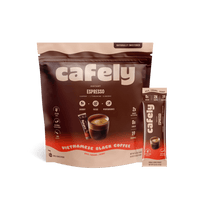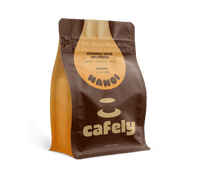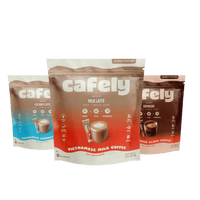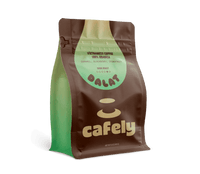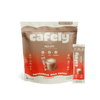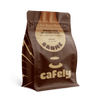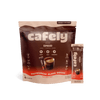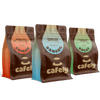A side effect of loving coffee is that you end up with a lot of coffee grounds. For the eco-conscious, throwing them out can seem like a waste. Thankfully, there are quite a few ways to reuse the leftover coffee grounds in your home, including body scrubs.
We'll run through the process of how to make a coffee scrub and explain why it can be such a beneficial addition to your wellness routine.
How to Make A Coffee Scrub
Repurposing coffee grounds to make a beauty product is an excellent way to save both the planet and your skin.
Cafely's signature coffee is handpicked, carefully dried, and roasted to perfection, preserving all the beneficial antioxidants coffee offers — while eliminating any toxic pesticides or chemicals.
The superior quality of this coffee extends to the scrub itself, making it even more effective. Follow along for our quick and simple recipe.
Ingredients

As with any wellness product, select ingredients of the highest quality for the best results, choosing options that are organic, all-natural, and fresh.
Ingredients needed to make a coffee scrub at home:
- ½ cup ground coffee — Fresh coffee is ideal, but you can substitute used grounds.
- ½ cup sugar or salt — Brown sugar, white sugar, or sea salt are all good choices. These ingredients have natural exfoliating properties and draw moisture out from the coffee grounds to form a homogenous mixture.
- ¼ – ½ cup of coconut oil — This is the most popular for beauty products because of its moisturizing, protective, and soothing properties, but you can also use other oils.
- 2 – 3 drops of essential oils or vanilla extract — Optional, but adding a pleasant aroma to your scrub can make the exfoliating process much more enjoyable.
Method
Making the scrub from your gathered ingredients is very simple, and you’ll likely be done with it before you know it.
4 easy steps to make exfoliating coffee scrub:
- Combine the coffee grounds and the sugar or salt in a large bowl.
- Mix well. Don't be afraid to be a little rough with the mixing. During this step, the sugar or salt grinds against the coffee and extracts moisture, which helps the scrub combine well.
- Slowly add the oil, stirring regularly. Adding the oil all at once won't allow it to be incorporated into the coffee as effectively. The consistency should end up feeling similar to wet sand.
- Add essential oils and extracts. Add a few drops across the surface of your scrub and mix in thoroughly. These ingredients tend to be potent, so start small and then add more if needed.
After you’re happy with the scrub, it’s time to store and use it. Place it in an airtight container and keep it in a cool spot.
When you’re ready to use it, scoop a little up on your fingers and massage it into your skin in circular motions. Then, rinse it off thoroughly and wash as normal, enjoying smooth, silky, and refreshed skin in only a matter of minutes.
Common Mistakes When Making DIY Coffee Scrub
Making a coffee scrub from scratch is a simple process, so not much can go wrong in the preparation.
However, if you select the wrong ingredients or store it improperly, you might end up with a scrub that's unpleasant to use and may not work as effectively.
Here are some common mistakes, and what you need to know to properly avoid them.
1. Using the Wrong Oil
As you'll know from the grocery store, there are a lot of different oils out there since they come from many sources, like animals, seeds, and nuts.
To make things more complicated, not all oils are created equal and can contain different compounds that offer you different benefits — or drawbacks.
Ideally, you want to select an oil that is liquid at room temperature and is less likely to clog your pores.
Try to avoid soybean, corn, canola, and citrus oils — these are frequently associated with clogged pores, increased inflammation, and general skin irritation.
Popular choices are olive oil and coconut oil. Olive oil, in particular, has been used in skincare for thousands of years and has been shown to have anti-inflammatory, antioxidant, and wound-healing properties, in addition to slowing skin aging and preventing skin cancer [1].
2. Using Instant Instead of Grounds
In the coffee world, instant coffee and ground coffee both have their place, but it's worth pointing out that they are very different.
Ground coffee is simply coffee beans that have been crushed into smaller parts, typically by using a grinder. Coffee grounds are the leftovers remaining after making your favorite brew.
On the other hand, instant coffee is brewed coffee that has been freeze-dried into a fine powder. Instant coffee granules will dissolve into the oil, leaving you with a goopy mixture that won't produce a functional exfoliant.
Be sure to use either fresh ground coffee or used coffee grounds instead of instant coffee — this way you'lll get the optimal amount of exfoliation with each face treatment.
Suggested: How to Grind Coffee Without A Grinder
3. Using Sugar or Salt That’s Too Fine
It’s important to use coarser sugar or salt so they can act as an exfoliant, which isn’t possible with fine powders.
As a general rule of thumb, aim to use granules around the size of granulated sugar or larger. Table salt is too fine.
Why Make a Coffee Scrub?

While making a coffee scrub can be an easy, eco-conscious skincare product, it may seem a little unnecessary. After all, there are plenty of cosmetic products — why not use some of those?
Well, it turns out that coffee has a number of wonderful benefits for your skin. We’ll discuss what coffee can provide for your skin, as well as how exfoliation can deliver a much-needed boost to your skincare regimen.
Benefits of Coffee
While most of the scientific literature focuses on eating or drinking coffee, caffeine and other core ingredients in coffee have been shown to be very beneficial for your skin.
1. Increase Collagen Production
For instance, there was a study in 2013 that explored how caffeic acid may be used in the skincare industry. The scientists found that the antioxidant compound may increase collagen production in the skin [2]. This is a common aim among skincare products, as it may help to reduce wrinkles, improve elasticity, and result in healthier-looking skin.
2. Reduce Signs of Aging
A separate study in 2015 explored the links between coffee consumption and skin health. Through speaking with participants, the study found a correlation between regularly drinking coffee and reduced effects of photoaging. In the study, the authors defined photoaging as pigmented spots and wrinkles [3].
3. Sun Protection & Cancer Prevention
Caffeine has many potential health benefits, including the iconic buzz of energy that helps you get through the day. However, research shows that topical application of coffee to the skin may provide sun protection and help prevent non-melanoma skin cancer [4].
All of the benefits that you receive from coffee start from the source. Choosing single-origin, Fair Trade coffee that's grown, harvested, dried, and roasted in the best conditions is the ideal way to get the most out of your coffee scrub and skincare routine.
Shop all Single-Origin Coffee Available from Cafely Here!
Benefits of Exfoliation
Exfoliation has long been a lauded practice in wellbeing circles. It can have a number of benefits, primarily that it helps slough away dead skin cells. Skin is naturally regenerating all the time, and by exfoliating, we can aid that process by removing the outermost dead skin cells.
Exfoliation might temporarily reduce cellulite and promote brighter and tighter skin while unclogging pores. Clogged pores can lead to acne and other unfavorable skin conditions.
Related: The Best Healthy Coffee Options for Wellness
What Other Uses Do Coffee Grounds Have?
Used coffee grounds are good for a whole host of different things, which is especially great if you drink as much coffee as we do. If you're already considering turning your coffee grounds into a face scrub, you may be interested in other ways to effectively use them.
1. Compost
People mainly reduce the impact of their coffee consumption by composting their coffee grounds. Used grounds can be added to a compost heap or food waste bins in most locations. In fact, there are even coffee companies that have created biodegradable filters, so you can simply throw the whole filter, coffee and all, onto your compost heap.
2. Fertilizer

Coffee can be used in soil as a form of fertilizer. Simply add coffee grounds directly to vegetable gardens, flower beds, and potted plants by sprinkling them in a light layer and mixing them into the soil. The used coffee grounds add essential nutrients to the soil, helping to improve aeration, water retention, and soil quality. However, coffee is acidic and can be detrimental to some plants.
Related: What Plants Like Coffee Grounds? (And How to Use It)
3. Insect Repellant
While this is much less common than using coffee grounds as a form of fertilizer, some people repurpose their used coffee grounds into incense or candles. Caffeine originally evolved in coffee beans as a natural insect repellent to protect the plant.
When the grounds are dried and combined with wax to make a candle, the resulting smell and smoke from the candle work well as an insect repellent.
Related: How to Burn Coffee Grounds Like Incense
4. Fire Starters
Similarly, there are ways to turn coffee grounds into simple logs for fires. The grounds are collected, dried, and pressed into compact bricks. Then, they can be added to a fire to help it burn well. These bricks are often said to be best suited to a fire pit or chiminea outside since the resulting smoke can be strong. As previously noted, it has insect-repelling properties, an added benefit to burning it.
FAQs: How to Make Coffee Scrub
Making a coffee scrub is a great way to boost your DIY skincare game. Let's address some FAQs to clarify where there may be some confusion.
1. How to Make a Homemade Coffee Scrub?
Making a homemade coffee scrub is very simple and involves little more than simply mixing equal volumes of coffee grounds and an exfoliating ingredient like sugar or salt.
After mixing those ingredients, slowly add a moisturizing oil up to the same volume as the other ingredients or until you reach your desired consistency.
2. What Can You Mix With Coffee for Scrub?
To give your coffee scrub a little more personality, add a few drops of any essential oil or even vanilla extract. Adding these scents can make the scrub more enjoyable and even provide additional benefits.
3. What Are the Ingredients in Coffee Scrub?
The principal ingredients of coffee scrub are coffee grounds, sugar or salt, and moisturizing oil. Typically, coconut oil is used, but olive oil is another popular option. Some people decide to add a few drops of essential oil to give their scrub a unique scent.
4. Is a Homemade Coffee Scrub Good for Skin?
Yes, homemade coffee scrubs can be great for your skin. Coffee provides significant support for skin, including reducing the signs of aging and keeping it protected from the environment, while exfoliation is a great way to remove dead skin cells, smoothing skin and keeping you on top of your skincare regimen.
5. Is It Good to Scrub Your Body With Coffee?
Scrubbing your body with coffee is a great way to exfoliate, which can be a core part of maintaining healthy skin. Coffee provides extra benefits for your skin, including improving skin health, reducing signs of aging, and protecting your skin from sun damage and cancer.
6. Can I Use Nescafe Coffee for Scrub?
You can use any coffee grounds for your scrub, but instant coffee granules won't work. The instant granules are freeze-dried brewed coffee and will turn into a paste when combined with the oil.
7. How Does Coffee Tighten Skin?
Caffeine may improve blood flow and circulation in the skin, and a combination of its vasoconstricting effects and physical exfoliation may also help to tighten the skin.
8. How to Make a Coffee Scrub Without Coconut Oil?
Technically, you can use any moisturizing oil as a replacement for coconut oil in a coffee scrub. However, not all oils are ideal for your skin. Olive oil is a popular choice to replace coconut oil because of its numerous skin-enhancing benefits.
9. Does Coffee Scrub Remove a Tan?
Yes, a coffee scrub may remove a tan. It's a natural exfoliant, so the scrubbing motion may remove tanned cells and reveal brighter skin underneath them.
10. How Long to Keep Coffee Scrub on Your Face?
It's generally wise to let the coffee scrub sit for around two to three minutes before washing it off. However, the scrubbing motion is the most impactful part of the process, so it's also safe to count the scrubbing time.
References
- Lin, T. K., Zhong, L., & Santiago, J. L. (2018). Anti-inflammatory and skin barrier repair effects of topical application of some plant oils. International journal of molecular sciences, 19(1), 70.
- Magnani, C., Isaac, V. L. B., Correa, M. A., & Salgado, H. R. N. (2014). Caffeic acid: a review of its potential use in medications and cosmetics. Analytical methods, 6(10), 3203-3210.
- Fukushima, Y., Takahashi, Y., Hori, Y., Kishimoto, Y., Shiga, K., Tanaka, Y., Masunaga, E., Tani, M., Yokoyama, M., & Kondo, K. (2015). Skin photoprotection and consumption of coffee and polyphenols in healthy middle-aged Japanese females. International journal of dermatology, 54(4), 410–418.
- Elias, M. L., Israeli, A. F., & Madan, R. (2023). Caffeine in skincare: Its Role in skin Cancer, sun protection, and cosmetics. Indian Journal of Dermatology, 68(5), 546-550.
